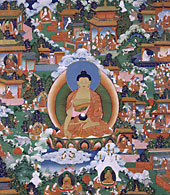Exhibition
Reflects Dalai Lama's Message

Shakyamuni
Buddha with Avadana Legend Scenes. Click on
image to view enlarged version. |
Wisdom, compassion
and peace emanate from a collection of Buddhist art in an
exhibition that opened May 4 in the lower level of the Museum
of Art.
The exhibition, which
honors the visit of the 14th Dalai Lama to Smith on
May 9, features a roomful of Tibetan tangkas (paintings on
cloth) from the 14th through 19th centuries, as well as four
sculptures of Buddhist figures. The works are on loan from
the Rubin Museum of Art in New York City and the collection
of Shelley and Donald Rubin.
“Aesthetics of
the Sacred: The Buddhist Art of Tibet,” which was curated
by Marylin Rhie, professor of art and East Asian studies,
runs through August 4. Rhie will give a gallery talk on Friday,
May 11, at 6 p.m. It is free and open to the public.
The tangkas depict
a variety of subjects from the vast iconography of Tibetan
Buddhist art, grouped into three sections illustrating Tibetan
Sacred History, Masters From the Four Major Orders, and Icons
of Practice and Protection. Paintings include images of the
Buddha Shakyamuni, his disciples, known as Arhats, Bodhisattvas
(those on the path to enlightenment), mahasiddhas (yogic
practitioners), portraits of the famous lamas, and the fierce
protector images, among others. Some are surrounded by
intricate scenes of the past lives of the Buddha, or life
events of famous masters, such as Milarepa. The
central figures are typically seated in peaceful repose
amid a symmetrically balanced tableau of harmonious arrangements
of lamas, practice deities and protectors, with depictions
of pristine blue-green mountains or richly detailed landscapes.
In Shakyamuni Buddha
with Avadana Legend Scenes,
for example, the Buddha Shakyamuni -- the historical Buddha
also known as Gautama Buddha -- sits in a lotus position
making the vara (giving) gesture with his right hand. He
is surrounded by scenes and people from his past and present
lives.
Another painting, Milarepa
and Life Scenes, features
Milarepa, the beloved Tibetan Buddhist poet, saint and
teacher from the 11th century, seated in a cave flanked
by a dense array of miniature scenes of his life set within
a rich mixture of dark red and green rocky landscape.
The sculptures include
some of the finest images of the 14th and 15th centuries
depicting the Buddha Shakyamuni, the mystical Buddha Vajradhara,
a yogic adept (Mahasiddha) and,
in the case of Begtse, offer a rare early 18th-century
gilt copper statue from Outer Mongolia. This superb sculpture
is posed with flailing sword and wears a coat of mail
as befits this warrior protector of Buddhism.
Since the 14th
Dalai Lama fled Tibet in 1959 amid an invasion by China,
Tibetan art has become well-known throughout
the world. The works in “Aesthetics of the Sacred” represent
the purity, calm and meditative power inherent in Tibetan
art that seeks to bring the sublime world of enlightenment
into our world as an inspiration for meditation
and devotion, and to reveal the aesthetics of the profoundly
mystical realms.
The Rubin Museum collection is the most extensive of Tibetan
art in the United States with several thousand objects.
“Aesthetics of
the Sacred” is
supported by the East Asian Studies Program, the Ada Howe
Kent Fund and the Brown Foundation, Inc., of Houston.
|























